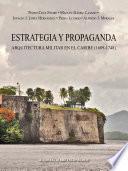Estrategia y Propaganda. Arquitectura militar en el Caribe (1689-1748)
Sinopsis del Libro

El patrimonio militar construido en el Caribe cuenta con unos notables valores culturales, todavía poco conocidos internacionalmente. Todos estos proyectos, llegaran a construirse o no e independientemente de su estado de conservación, se definen con dos características inseparables: su función defensiva y su valor como elemento de una imagen del poder gobernante. La complejidad de estas propuestas de estrategia y propaganda, han llevado a plantear como objetivo principal de este trabajo demostrar que cada potencia europea planteó un modelo de gestión. Esto fue posible a partir de unos paradigmas teóricos que se definieron mediante la trasferencia técnica el desarrollo urbano de las ciudades y el geográfico de las regiones, así como la propia defensa de las poblaciones bajo su gobierno. El ámbito geográfico elegido engloba tanto los puertos del Caribe como los del Golfo de México, incluyendo no solo los mayoritarios administrados por el gobierno español sino también los de otras potencias europeas como Francia, Inglaterra, Holanda y Dinamarca. El marco cronológico se desarrolla entre 1689 y 1748, lo que permite abordar el impacto bélico internacional en la zona, desde la Guerra de los Nueve Años hasta la de la Oreja de Jenkins o del Asiento. Con los resultados del trabajo se pretende no solo un incremento de conocimiento, sino también su transferencia para, entre otras posibilidades, dar respuesta al interés suscitado entre el turismo internacional y las poblaciones locales, o en los círculos académicos, dedicados a este tipo de patrimonio. The fortresses built in the Caribbean form a heritage of remarkable cultural values which are still not internationally known. All these buildings, whether they were finished or not and regardless of their state of conservation, are defined by two inseparable characteristics: their defensive function and their value as an element of an image of the governing power. The complexity of these proposals of strategy and propaganda, have led to propose as the main objective of this work to demonstrate that each European power raised a model of management. This was possible from some theoretical paradigms that were defined through the technical transference of the urban development of the cities and the geographical development of the regions, as well as the own defense of the populations under their government. The geographical scope chosen in this work includes both the ports of the Caribbean and those of the Gulf of Mexico, including not only the majority ports administered by the Spanish government but also those of other European powers such as France, England, Holland and Denmark. The chronological frame is developed between 1689 and 1748, which allows approaching the international war impact in the area, from the Nine Years War to the Jenkins' Ear or the Seat War. The results of the work are intended not only to increase knowledge but also to transfer it in order to respond to the interest raised among international tourism and local populations, or in academic circles, dedicated to this type of heritage.
Ficha Técnica del Libro
Número de páginas 230
Autor:
- Pedro Cruz Freire
- Ignacio J. López Hernández
- Manuel Gámez Casado
Categoría:
Formatos Disponibles:
MOBI, EPUB, PDF
¿Cómo descargar el libro?
Valoración
4.5
25 Valoraciones Totales







